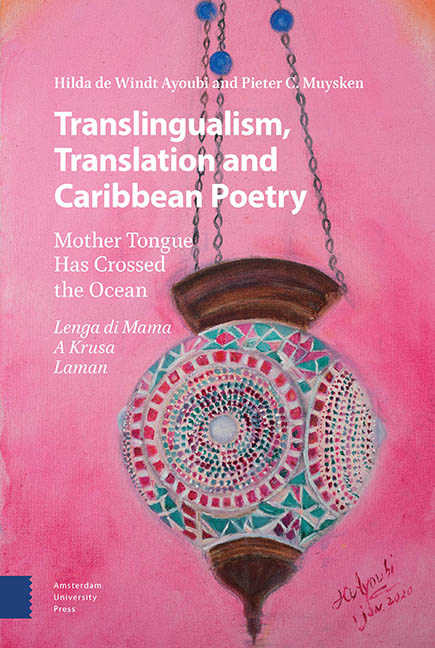Book contents
- Frontmatter
- Dedication
- Contents
- How to Navigate This Book: Kon Nabegá den e Buki akí
- Acknowledgements
- Preface
- Part 1 Introducing the Mother Tongue: Introdukshon di Lenga di Mama
- Part 2 The Poem “Lenga di Mama” and its Translations, Comments and Language Descriptions E Poema “Lenga di Mama” i su Tradukshonnan i Komentario i Deskripshon di e Idiomanan
- Part 3 The Poem “E ‘papiá’ di Papiamentu” and its Translations E Poema “E ‘papiá’ di Papiamentu” i su Tradukshonnan
- Part 4 The Poem “Papiamentu pa Semper” and its Translations E Poema “Papiamentu pa Semper” i su Tradukshonnan: The Translations and Editing of the Poem Hilda de Windt Ayoubi and Pieter Muysken (for Dutch)
- Part 5 The Poem “Riba Ala di Lenga di Mama” and its Translations E Poema “Riba Ala di Lenga di Mama” i su Tradukshonnan
- Part 6 Commentary: Komentario
- Note on the Authors: Informashon tokante e Outornan
- Index: Índise
Amerindian Languages: Idioma Amerindio
Published online by Cambridge University Press: 15 September 2022
- Frontmatter
- Dedication
- Contents
- How to Navigate This Book: Kon Nabegá den e Buki akí
- Acknowledgements
- Preface
- Part 1 Introducing the Mother Tongue: Introdukshon di Lenga di Mama
- Part 2 The Poem “Lenga di Mama” and its Translations, Comments and Language Descriptions E Poema “Lenga di Mama” i su Tradukshonnan i Komentario i Deskripshon di e Idiomanan
- Part 3 The Poem “E ‘papiá’ di Papiamentu” and its Translations E Poema “E ‘papiá’ di Papiamentu” i su Tradukshonnan
- Part 4 The Poem “Papiamentu pa Semper” and its Translations E Poema “Papiamentu pa Semper” i su Tradukshonnan: The Translations and Editing of the Poem Hilda de Windt Ayoubi and Pieter Muysken (for Dutch)
- Part 5 The Poem “Riba Ala di Lenga di Mama” and its Translations E Poema “Riba Ala di Lenga di Mama” i su Tradukshonnan
- Part 6 Commentary: Komentario
- Note on the Authors: Informashon tokante e Outornan
- Index: Índise
Summary
Abstract
This section presents translations into some ofthe indigenous languages of the Americas. Theselanguages belong to a great many languagefamilies; in South America alone there are over ahundred families. Thus, the languages are by nomeans all related, as the reader might haveexpected. When we say that they are not related wemean that they do not share enough similar wordsto ascertain or determine that they are related.Nonetheless, many of them share grammaticalfeatures, such as tendencies to place much of thesentence information in verb endings.
Keywords: Amerindian, Americas,North America, South America, Meso- America,Endangered Languages
Many Amerindian languages are seriously endangered.Only a handful in each continent have a substantialnumber of speakers, and even these are not growingin speaker numbers, for the most part. In this bookthere are translations from one language ofMeso-America, Nahuatl, and of half a dozen languagesfrom South America. We present the Amerindianlanguages roughly from north to south.
Náhuatl (Nahuatl in English) is one of thebest known indigenous languages of Mexico, and amajor language of the Uto-Aztecan language family.There are over one and a half million speakers. Thelanguage was spoken by the Aztecs, who lived incentral Mexico and founded what is now Mexico City,then Tenochtitlan. Words in English with a Náhuatlorigin include avocado, chocolate, and tomato.Pre-Columbian Aztec writing was image-based and didnot represent the full language, but texts (calledcodices) served as a memory aid for people narratinga text. With the Spanish conquest, the Latin scriptwas introduced to represent Náhuatl, and many texts,both prose and poetry, have been preserved since thesixteenth century, relying on the earlier pictorialrepresentations in many cases. One of the featuresof Náhuatl is the possibility of adding the objectof the verb directly to the verb itself, as inni-naka-kwa “I eatmeat” (literally I-flesh-eat). There are someSpanish loans in Náhuatl, such as maske “more than” (<Spanish más que) inthe translation.
Wayuunaiki (also called Wayuu or Guajiro)is the language of the Wayuu; sometimes the languageis also referred to by the name of the group. It is,for Amerindian languages, a surprisingly stronglanguage, with over 300,000 speakers.
- Type
- Chapter
- Information
- Translingualism, Translation and Caribbean PoetryMother Tongue Has Crossed the Ocean, pp. 113 - 136Publisher: Amsterdam University PressPrint publication year: 2022



